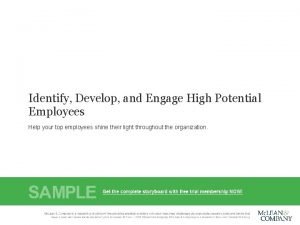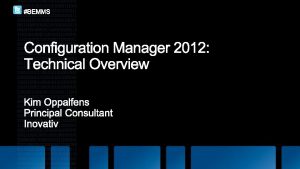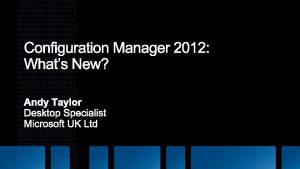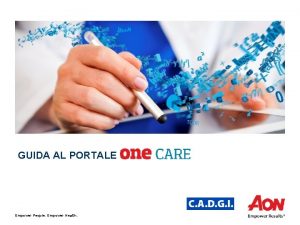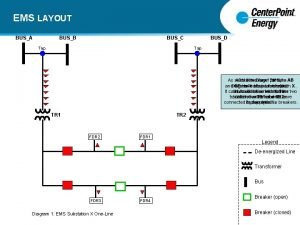Empower to Engage Tap the potential of the












- Slides: 12

Empower to Engage Tap the potential of the number one driver of employee engagement. Mc. Lean & Company 1

Introduction Employee empowerment is the biggest driver of engagement, yet only one- third of employees are empowered. How to empower, and how much to empower, depends on the scenario – it is not a one-size-fits-all proposal. This Research is Designed For: üHR professionals seeking to educate their management team on the topic of employee empowerment. This deck is directed towards managers. Pass it on to your management team. üManagers interested in the topic of employee empowerment who are looking for ways to empower their employees, even if employee empowerment isn’t supported by the organization. This Research Will Help You: üRecognize and demonstrate the organizational and individual benefits that come with empowering employees. üUnderstand how organizational support of empowerment and the employee’s capacity affect the degree to which you can empower each of your employees. üStart successfully empowering your employees while offering them the support they need to reach their goals and the organization’s objectives. Mc. Lean & Company 2

Executive Summary • Effective employee empowerment is the biggest driver of employee engagement, a current hot topic in the HR world. Empowerment has a significant impact on an organization’s customer service, profitability, productivity, and retention. • Despite this, many managers are reluctant to give up control due to low trust in employee ability to make the right decisions. On the other side of the continuum, many managers delegate all responsibilities with little to no boundaries in an attempt to empower. • The effectiveness of employee empowerment is tied closely to the strength of the employee-manager relationship, which is thus integral to empowerment success. • Disempowerment and disengagement go hand in hand. Only 3% of disengaged employees are empowered. • There are some cases in which empowerment isn’t appropriate. Allow employees only the degree of empowerment that they can handle and to the extent the organization will tolerate. Empowerment levels vary significantly by organization. • “A” performers and those employees over 54 years old are the most likely to be empowered. • Use opportunities in which you have empowered employees to coach your staff using the GROW model. • Many well-known organizations have successfully empowered their employees, leading to strong business results, including 3 M, Google, Best Buy, Zappos, and Whole Foods. • As a manager, you are responsible for fostering an environment in which employees can be empowered and for providing them with appropriate opportunities. However, empowerment is not something you give the employee – they must take the initiative and be willing. In the past, work was defined primarily by putting in time, and secondarily on getting results. We need to flip that model. NO matter what kind of business you’re in, it’s time to throw away the tardy slips, time clocks and outdated industrial-age thinking. – Cali Ressler, former HR Executive at Best Buy, who invented ROWE (Results Only Work Environment) Mc. Lean & Company 3

Make the Case What’s in this Section: • A significant percentage of employees are not empowered in their roles. • Employee empowerment is the number one driver of employee engagement, and is becoming more and more important. • Beyond engagement, empowerment improves Sections: Make the case Understand the factors that affect empowerment Start empowering Provide support during and after Play your role retention, productivity, customer service, and employee happiness. Mc. Lean & Company 4

Understand the definition of empowerment and acknowledge that two-thirds of your employees could be disempowered Empowerment is the degree to which employees have accountability and control over their work within a supported environment. Empowerment is not… Only 34% of employees are empowered empowering, but empowerment is a broader concept. The manager has a role beyond simply delegating. • Giving up all power: Empowerment is the sharing of power between the manager and employee. • Something that a manager bestows to the employee: The relationship is a partnership where the manager and employee share power depending on the scenario. Employees shouldn’t wait around to be empowered, but a manager does need to create a culture where employees feel comfortable and enabled to do their work and behave in an autonomous manner. • A process that happens only when a manager gives a green light: The manager shouldn’t have to formally delegate a task to the employee in order for the employee to feel empowered to do it. Empowered employees will always think about better ways to do things, even if the manager hasn’t asked them to. % of Respondents • Delegation without support: Delegating is an example of 100% 90% 80% 70% 60% 50% 40% 30% 20% 10% 0% 34% 37% 29% Empowerment Source: Mc. Lean & Company, 2011 N = 1226 Disempowered Not Empowered Empowerment is allowing employees to be mini. CEOs for their piece of the process. -VP, Professional Services Mc. Lean & Company 5

Employee empowerment is now crucial – there is more to do with increasingly less daily oversight Why Now? Times Have Changed Recent rounds of downsizing have dramatically cut middle management ranks. Fewer managers now oversee more employees than they did twenty, ten, or even five years ago. “Bodies in seats” is no longer a valid measure of employee productivity (and never really was). Quality of outputs, delivered on time and on spec, is the new yardstick of success. Goal achievement is far more important than how employees get there. Fewer informed “eyes” on a higher number of moving parts means that errors and omissions will increase if employees on the ground are uninformed and unsure where to look for answers. Myths about extrinsic motivators like money have been busted by extensive research. Intrinsic motivators like autonomy, professional pride, and trust are the true drivers of individual and business performance. In fact, compensation and benefits have a very low impact on employee engagement compared to all other drivers of engagement. Fewer management-level decision makers means an increase in critical decision delays and hurried decisionmaking if front-line staff don’t have the ability and authority to make those decisions as needed. Rigid, vertical hierarchies based on a “command control” management style create obstacles for survival and growth. Organizations that are not flexible and responsive to change will be left in the dust by their competition. This era doesn’t call for better management. It calls for a renaissance of self-direction. – Daniel Pink, bestselling author Mc. Lean & Company 6

Additionally, employee empowerment is a driver of employee engagement, currently a hot topic in the world of HR Employee empowerment drives employee engagement… • Employees have a better understanding of how they contribute to the organization’s mission and goals. • Employees feel responsible for and invested in the Overall Engagement organization’s success. • Employees can Job Org leverage their Engagement strengths. …and employee engagement drives key business metrics. Difference between top and bottom quartile of engaged workforces. Engaged workforces in the top quartile have: Engagement Drivers Development Co-worker Relationships Manager Relationship Rewards & Recognition Employee Empowerment Compensation Culture Customer Focus Company Potential Department Relationships Senior Mgmt Relationship Retention Drivers Benefits Working conditions Personal Disposition Out of a selection of HR areas, Employee Engagement was allocated the highest percentage of resources for 2011 at an average of 20%. Source: Mc. Lean & Company 7

Compared to other drivers, employee empowerment has the largest impact on engagement levels Employee empowerment not only has the highest correlation with engagement, but it also has the steepest incline, which means that it is the most impactful driver on employee engagement. Incline* of Relationship with Overall Engagement High Working Conditions Co-worker Relationships Med Benefits Low Compensation Low Working Conditions Senior Management Relationship Compensation Senior Management Relationship Development Rewards and Recognition Med Correlation* with Overall Engagement Source: Mc. Lean & Company; N = 1191 Employee Empowerment Benefits Customer Focus Manager Relationships Department Relationships Overall impact on engagement Employee Empowerment Culture Company Potential Department Relationships Company Potential High Why does empowerment have the biggest impact on engagement? Empowerment is one of the most personal drivers of engagement – it leverages and validates an employee’s ability. Additionally, it heavily impacts a lot of other engagement drivers. Empowered employees likely have a strong relationship with their manager, trust senior management, and feel more recognized and rewarded. Development Rewards and Recognition Co-worker Relationships Manager Relationships Culture Customer Focus What does this mean to you? The more you empower your employees, the more likely they are to be engaged. L e g e n d *Incline is magnitude of the relationship. The steeper the incline, the greater the increase in engagement when the driver is improved by one point. *Correlation is the degree of the relationship between each driver and engagement. Mc. Lean & Company 8

Beyond engagement, empowerment has countless additional benefits to the organization Benefit Why? 1. Improved customer service Armed with knowledge and a specific level of authority, employees can solve problems and better serve customers. 2. Increased revenue and profitability Creating an atmosphere that encourages empowerment at HCL Technologies led to increased revenue of 360% and increased operating profit of 340%, according to Vineet Nayar, CEO. 3. Increased productivity Empowered employees are invested in the organization’s success, and therefore, spend less time on non-work related activities. Plus, managers trust their staff to do their job and aren’t doing employees’ jobs on top of their own. 4. Improved retention Empowerment levels are strongly related to employee retention. Of all drivers, empowerment has the second greatest correlation with intent to stay. Culture Employee Empowerment Company Potential Senior Management. . . Compensation Working Conditions Rewards & Recognition Customer Focus Development Benefits Manager Relationships Department Relationships Co-worker Relationships What do these correlation numbers mean? 0. 50 0. 55 0. 60 0. 65 Correlation Interpretation 0. 0 to 0. 2 Very weak to negligible correlation 0. 2 to 0. 4 Weak, low correlation 0. 4 to 0. 7 Moderate correlation 0. 7 to 0. 9 Strong, high correlation 0. 9 to 1. 0 Very strong correlation 0. 70 Correlation with Retention Source: Mc. Lean & Company; N = 1018 Mc. Lean & Company 9

Empowerment positively impacts individuals as well as the organization Employees will not take responsibility for their actions if the boss is looking over their shoulders all the time. They will not take the initiative to work that extra hour, make that extra call or squeeze that little bit more out of a negotiation. – Richard Branson Benefit Why? 1. Employees are happier at work and home. Job autonomy has a strong statistical significance with less negative spillover from work to life, greater life satisfaction, and better mental health (Source: study conducted by The Families and Work Institute). 2. Employees have insight that managers don’t. Fifty-nine percent of workers spot problems that their organization’s management don’t know about (Source: survey of 700 private sector workers, commissioned by HCL Technologies). 3. Managers have more time to focus on strategic issues. Especially in today's knowledge driven economy, employee empowerment is critical to success. If you want the real benefits of your employees, you must free them to make decisions. In turn, this frees management to focus on larger strategic goals and initiatives. – Paul Craig, Sales Manager of Image Source, Xerox sales agency Mc. Lean & Company 10

Despite increased understanding of the importance of empowerment, there is still much room for improvement “Disengaged” and “Indifferent” employees are significantly disempowered – this is likely a strong contributor to their disengagement. Disempowerment and disengagement go hand in hand. These “double threat” employees are a major management concern because they’re likely to be less productive than their peers, and can significantly hurt team morale. Considering that two-thirds of employees are disempowered, the negative impact on overall engagement could be disastrous and shouldn’t be ignored. Managers must take note. Engaged Almost Engaged 12% 1% 87% 6% Indifferent 38% 57% 27% Disengaged 56% 17% 74% 0% 23% 3% 10% 20% 30% 40% 50% 60% 70% 80% 90% 100% % Respondents Disempowered Not Empowered Source: Mc. Lean & Company N = 1216 Disengaged employees not only have a negative impact on their own productivity levels and commitment to the organization, but also have a negative impact on their peers’ engagement levels. For an example demonstrating how one disengaged employee cost his organization $207, 000, see the solution set, Identify & Reengage the Disengaged. Mc. Lean & Company 11

Mc. Lean & Company Helps HR Professionals To: ü Empower management to applyü HR best practices ü Develop effective talent acquisition & retention strategies ü Build a high performance culture Maintain a progressive set of HR policies & procedures ü Demonstrate the business impact of HR ü Stay abreast of HR trends & technologies Sign up for free trial membership to get practical solutions for your HR challenges "Mc. Lean & Company provides practical research, tools and advice covering the entire spectrum of HR & Leadership issues to ensure you experience measurable, positive results. " • - Rob Garmaise, VP of Customer Experience Toll Free: 1 -877 -281 -0480 hr. mcleanco. com Mc. Lean & Company 12
 Two hands go clap clap clap
Two hands go clap clap clap Educate empower evolve
Educate empower evolve How to engage high potential employees
How to engage high potential employees Succinylcholine dose
Succinylcholine dose Graded potential vs action potential
Graded potential vs action potential Electric potential from electric field
Electric potential from electric field Axon hillock
Axon hillock How to find pressure potential
How to find pressure potential Electrostatic potential difference
Electrostatic potential difference Water potential definition biology
Water potential definition biology Action potential
Action potential Pe q
Pe q Action potential resting potential
Action potential resting potential


